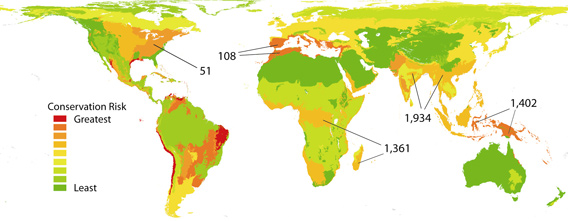Mapping the future of conservation
Mapping the future of conservation
mongabay.com
February 28, 2008
A new series of maps projecting habitat loss and the impact of climate change show that the world’s most biodiverse regions are in most of need of conservation investments. The authors say the study, published online today in the journal Proceedings of the Royal Society B, will help drive future conservation decisions.
“There’s a huge discrepancy between where the world’s conservation resources are concentrated and where the greatest threats to biodiversity are projected to come from future global change,” said Walter Jetz, an assistant professor of biological sciences at the University of California at San Diego who headed the project. “The developed nations are where the world’s wealth is concentrated, but they are not the future battlegrounds for conservation.”
 The map shows regions color-ranked by how much area is projected to change by 2100 in relation to how much area is currently protected (“Conservation Risk”). Many of the tropical, but not temperate regions with greatest risk (red) are also of highest conservation value as indicated by their higher number of globally unique amphibians, birds, mammals and reptiles. High change-protection ratio and much unique biodiversity combine to high conservation need. |
“While many details still have to be worked out, our study is a first baseline attempt on a global scale to quantitatively demonstrate the urgent need to plan reserves and other conservation efforts in view of future global change impacts,” he continued. “Reserves have often been set up haphazardly, following some national goal, such as to preserve 10 percent of a country’s area, or in response to past threats. But little consideration has been given to the actual geography of future threats in relation to biodiversity. Yet it’s those future threats that expose biodiversity to extinction.”
Analyzing the impact of climate and land use changes on protected areas around the world and comparing them to four projections of future global warming, agricultural expansion and human population growth from the global Millennium Ecosystem Assessment, Jetz and colleagues found that “past human impacts on the land poorly predicted the future impacts of climate change, revealing the inadequacy of current global conservation plans.”
“The past can only guide you so much in the future,” said lead author Tien Ming Lee, a graduate student at UC San Diego. “This is why we may have to change our future conservation priorities if we want to be effective in conserving biodiversity in the long run.”
Lee says that conservation in threatened tropical regions would both protect biodiversity and help fight climate change.
“Tropical countries are currently sitting on vast tracts of forests that are substantial carbon sinks and if they can get adequate financial help to protect these habitats, both global climate change and biodiversity loss could be mitigated,” he said.
This article is based on a news release from UC San Diego.







